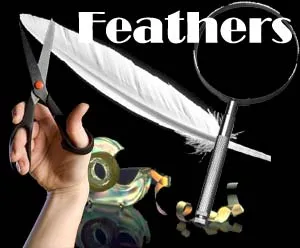 The Teacher's Corner
The Teacher's Corner
Feathers Science Experiment
This week's experiment came from one of my walks on the beach. At the edge of the water, I found several feathers. As I was photographing them, I began thinking about all of the science involved in the function of feathers, and I knew that I had this week's experiment.
To explore this, you will need:
 a feather (You can get them in craft stores if you don't have one.)
a feather (You can get them in craft stores if you don't have one.)- scissors
- paper
- tape
- a magnifying glass
First, don't go out and collect feathers from wild birds. Most wild birds are protected and in many places it is against the law to have their feathers. It is OK to have feathers from domestic birds, such as chickens and ducks. That is what you will find in most craft stores. They will work very well for our purposes.
Feathers are quite wonderful things. To help the bird fly, they need to be light, strong, and able to provide a broad surface to push against the air. We can see how this works by taking a closer look at the feather.
A little examination will show that a feather is indeed light. You can see why by using scissors to cut through the central shaft of the feather, which is called the rachis. You will find that it is a hollow tube. The thickest part of the feather is a thin tube, filled with air. No wonder it is light. But, if it is hollow, how can it also be strong enough to lift the weight of the bird?
You can see where the strength comes from by using a sheet of paper. When it is flat, it bends very easily, but try rolling the paper into a tube. Use some tape to keep the tube from unrolling. Gentle testing will show you that the paper tube is much more resistant to bending than the flat sheet of paper, and that it can support quite a bit more weight. This shape gives the feather the strength it needs.
Besides being light and strong, the feather also needs to be able to push against the air. For this to work, the feathers must form a solid wing. The part of the feather that forms this surface is called the vane. Look closely and you will see that the vane is made up of many long, hair-like structures called barbs. For the feather to do its job, these barbs must stick together to form a continuous surface. At first your feather may fit that description, but if you pull gently, you can easily separate the barbs. Now your feather will let the air flow through. A bird with too many feathers in that condition would not be able to get off the ground.
Luckily, the feather is easily fixed. Use your fingers to smooth the barbs back into place. You should find that they once again stick together to form the continuous surface that the bird needs. How can they do that?
If you have a magnifying glass, use it to look closely at the barbs. Each barb has many tiny hooks, called barbules. These hooks interlock with the barbules from the next barb, acting very much in the same way that Velcro does. This makes the feather easily repairable. By pulling the feather through its beak, the bird can stick the barbs back together, so the feather can continue doing its job.
Feathers do much more than just help the bird fly. They trap air against the bird's skin, forming a wonderful layer of insulation. This keeps the bird warm in winter. Feathers also overlap to form a smooth, streamlined covering to help the bird's body slip easily through the air. They give the bird its color too. All in all, they make a wonderful covering for the bird.
Have a wonder filled week.
All lessons are brought to you by The Teacher's Corner and Robert Krampf's Science Education Company.
Robert Krampf's Science Shows thehappyscientist.com
